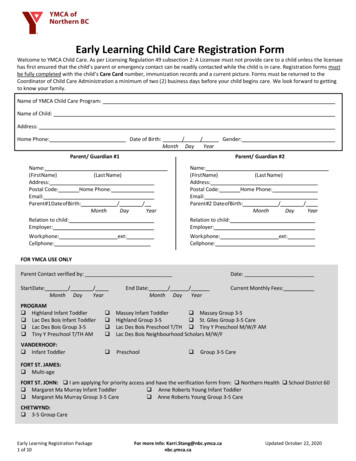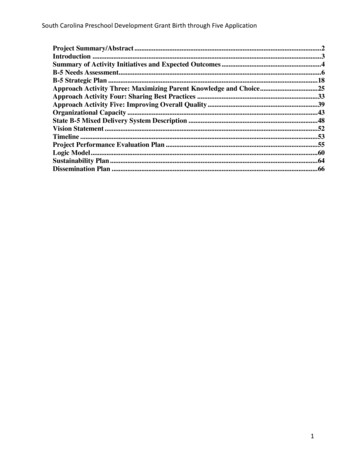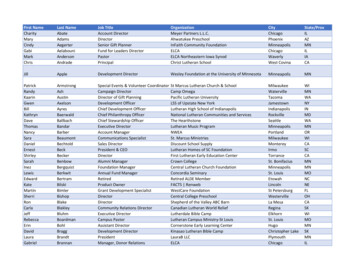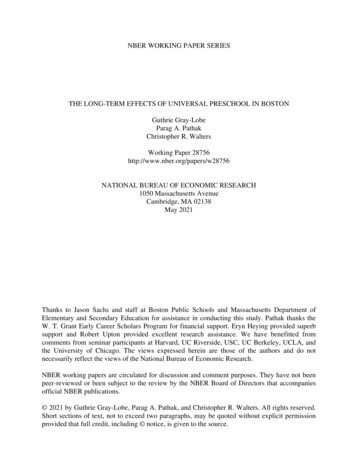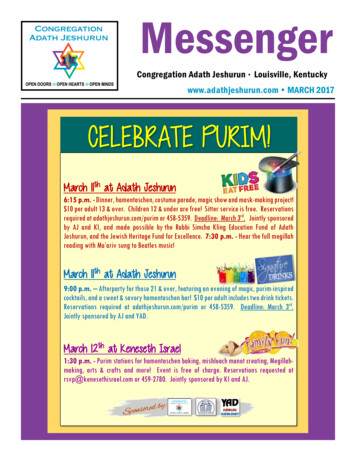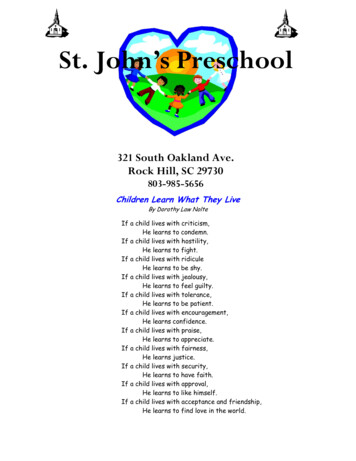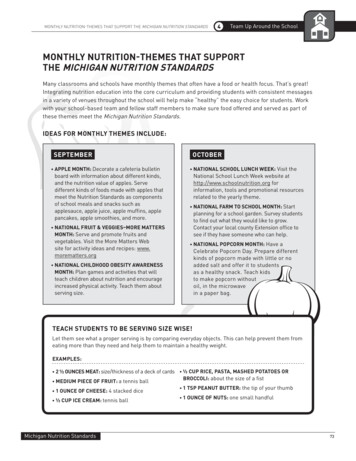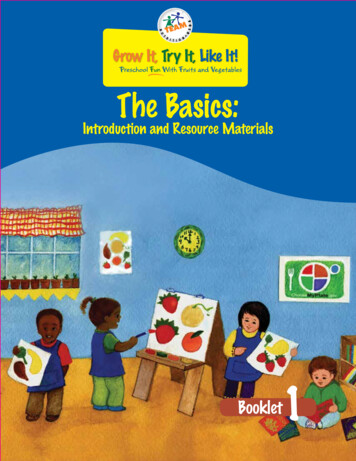
Transcription
Grow It, Try It, Like It!Preschool Fun With Fruits and VegetablesThe Basics:Introduction and Resource MaterialsBooklet1
Table of ContentsIntroductionAcknowledgementsWelcome to Grow It,Try It, Like It!. 1How To Use Grow It,Try It, Like It!. 2Map of the Garden at Tasty Acres Farm. 6Teaching Guide. 9Nutrition Education Guide. 9Growing Great Tasters: Strategies for Food Tasting.17Garden Art and Crafts.19Grow Your Own Great Ideas.21Art and Crafts Chart.22Decorated Garden Bags.27Garden Bookmarks.28Produce Placemats.29Garden Scene Note Cards.30Tasty Acres Mobile.31Stamped Wrapping Paper.32Row Markers.33Seed Art.34Painted Pots.35Garden Stones.36Garden Gloves.37Make a Scarecrow.38Tool Shed Resources.40Growing at Home Introduction Letter to Parents.42Hand Washing/Polite Tasting Guides.43Make a Mystery Bag.45Tips for Using a Mystery Box/Bag.46Ten Terrific Ways To Serve.48A Harvest of Books.50
Green Thumb Guides.52Grow a Seedling in a Bag.52Grow Seedlings Indoors.53Make a Seed Tape.54Container Gardens.55Gardening Outdoors.58Fruit and Vegetable Drawings .61-72Blackline Masters.73MyPlate Coloring Page.83CD ContentCD 1. Cool Puppy Pup DVDa. Cool Puppy Pup’s Picnicb. Cool Puppy Pup’s Crookneck Squash Lunch Partyc. Cool Puppy Pup’s Spinach Lunch Partyd. Cool Puppy Pup’s Sweet Potato Lunch Partye. Cool Puppy Pup’s Cantaloupe Lunch Partyf. Cool Puppy Pup’s Peach Lunch Partyg. Cool Puppy Pup’s Strawberry Lunch PartyCD 2. Grow It, Try It, Like It! Supplemental Materialsa. Grow It, Try It, Like It! PDF Versionb. Nutrition and Wellness Tips for Young Children: Provider Handbook for theChild and Adult Care Food Program PDF Versionc. Food and Nutrition Fun for Children 20081. Kids in the Kitchen2. Food Fun3. Learning About Food and Healthy Eating4. Reading Fun5. Food From Around the World6. Physical Activity7. Online Booklists and Web sitesd. Child Care and Nutrition WebsitesEat Smart To Play Hard With MyPlate Poster
IntroductionAcknowledgementsAgricultural Marketing Service, USDAAmerican Dietetic AssociationMichelle Warren Katrina HoltFood and Nutrition Service, USDARayane AbuSabha Lori French Mara McElmurrayJan Adams Stanley Garnett Elaine McLaughlinAnne Bartholomew Gerry Howell Joan TuretskyHeidi Bishop Linda Jupin Vicky UrcuyoDorothy Caldwell Louise Lapeze Cheryl WilsonLorie ConneenSandra LeflerJulie FortAlice LockettSpecial Nutrition Programs Nutritionists from the Mid-Atlantic Regional Office, MidwestRegional Office, Mountain Plains Regional Office, Northeast Regional Office, Southeast Regional Office,Southwest Regional Office, and the Western Regional Office.Heartland Child Nutrition, North Dakota Jefferson County ChildShirleen Piela (for Maggie Anderson) Development Council, AlabamaDot WillinghamMaryland State Department of EducationNational Agriculture Library, USDAPatricia FreemanKaren ReganLora WilderNational Food Service Management InstituteEnsley HowellPowhatan County School Board, VirginiaMartha GilbertProduce for Better Health Foundation,5 A Day ProgramKathy Cobb Rainbow Valley Day CareDaria Massimilla Homes, WashingtonPatricia Gattke (for Carolyn Morrison)Dr. Elizabeth PivonkaUniversity of MarylandProduce Marketing AssociationDr. Cynthia TuttleMolly MaguireDr. Susan WalkerUnited Fresh Fruit and Vegetable AssociationDonna DenisonA contract was awarded to Lumina Associates for the purpose of developing recipes for use in both the childcare facilities and in the Growing at Home materials.Qualitative testing of selective activities, taste testing of recipes with 3- to 5- year-old children, and the initial reviewof materials by child care teachers, home care providers, and Kindergarten teachers were conducted by a contractor,Laura Thomas, MEd, RD, LD, experienced in developing nutrition education materials for children.She also added narrative, edited the publication, and developed and/or revised selected recipes and activities.Project ManagerHeidi Bishop, Program Analyst, FNS USDA
4
Welcome to Grow It, Try It, Like It!Preschool Fun with Fruits and VegetablesGrow It, Try It, Like It! is a garden-themed nutrition education kit that introduces newfruits and vegetables to preschool age children. Grow It, Try It, Like It! was funded bythe U.S. Department of Agriculture’s (USDA) Team Nutrition. Team Nutrition is aninitiative of the USDA’s Food and Nutrition Service to support the Child NutritionPrograms through training and technical assistance for foodservice, nutritioneducation for children and their caregivers, and school and community supportfor healthy eating and physical activity. The goal of Team Nutrition is to improvechildren’s lifelong eating and physical activity habits through nutrition educationbased on the principles of the Dietary Guidelines for Americans and MyPlate. To learnmore about Team Nutrition and nutrition in child care go to the Team NutritionWeb site at teamnutrition.usda.gov and the Healthy Meals Resource SystemWeb site at http://fnic.nal.usda.govBecause the routine food choices of young children are determined by their familiesand adult care givers, Grow It, Try It, Like It! links activities at child care centers withresources for use at home. Children are encouraged to try new fruits and vegetablesagain and again throughout this delightful resource. Children touch, smell, and tastenew fruits and vegetables. Children also learn that fruits and vegetables are grownfrom plants or trees in the ground. Planting activities help children connect thedelicious food choices at the table with the different growing conditions and plantsthat produce fruits and vegetables.The 2010 Dietary Guidelines for Americans list fruits and vegetables as foods toencourage for increased consumption as part of a healthy eating plan among thegeneral population of the United States. Most Americans, including young children,need to eat a more colorful variety of fruits and vegetables (especially dried beansand peas, red and orange vegetables and dark green vegetables.) more often.Early childhood presents a unique opportunity to influence food acceptance andpreferences that have the potential to influence health over the lifespan. Introducinga variety of fruits and vegetables in positive, engaging activities increases thelikelihood that young children will taste and eat a wider variety of these healthpromoting foods.Consumption of vegetables and fruits is associated with reduced risk of manychronic diseases. This includes heart disease and some types of cancer. Eating fruitsand vegetables is also linked to a healthy body weight and is one dietary strategyto help reduce rates of obesity. The increased incidence of overweight and obesityamong Americans, including young children, is a growing national health concern.The Basics: Introduction and Resource Materials1
Young children have a natural curiosity about the world around them and a genuinedesire to learn. The activities in Grow It, Try It, Like It! tap into these characteristics ofpreschool children. The activities are designed with the needs of young children andchild care providers and centers in mind. The pages are filled with engaging activitiesand easy-to-follow instructions. Central throughout the resource are three mainconcepts: Children can have fun while learning about nutrient and fiber-rich foods such asfruits and vegetables.Fruits and vegetables grow from plants or trees in the ground, are harvested, andare taken from the farm or orchard to grocery stores and farmers’ markets.Fruits and vegetables can be prepared and eaten in many different and fun ways.Grow It, Try It, Like It! is more than a resource for introducing fruits and vegetables toyoung children. Grow It, Try It, Like It! provides learning opportunities that contributeto each child’s individual growth and development. Carefully crafted activitiesdevelop the entire child, body and mind, through: discussing ideas and developing vocabulary;enjoying physical movement;enhancing fine motor skills;reading children’s literature;singing familiar music;viewing an entertaining and educational video;participating in hands-on science activities featuring plants; andcreating individual art and crafts.The learning activities engage children through all of their five senses–sight, touch,sound, smell, and taste. While learning about fruits and vegetables, children grow,develop, and learn about themselves. The activities help foster both an acceptanceand enjoyment of new fruits and vegetables and an increase in self-confidencewhich can lead to higher self-esteem. The connections to home provide parents andguardians with ideas to further the growth and development of the entire family.Grow It, Try It, Like It! is a natural addition to any child care program.How to Use Grow It, Try It, Like It!Grow It, Try It, Like It! is organized around a garden theme, based at theimaginary Tasty Acres Farm. The map on pages 6-7 shows the imaginary gardenat Tasty Acres Farm. Make copies of this map for each child to color as thedifferent units are covered. This is a great way to chart progress through thesix booklets.2Grow It, Try It, Like It!
Grow It, Try It, Like It! consists of seven booklets. Booklet 1 contains the Introduction,Teaching Guide, Garden Art and Crafts and Tool Shed Resources, Cool Puppy PupDVD and the Supplemental Materials CD. Booklets 2 through 7 contain the activitiesfor the six fruit and vegetable lessons.Booklet 1 acknowledges those who helped in the kit’s development and pro-vides a description of the kit and Team Nutrition. The introduction also describeshow to use the kit and how the kit is organized.Teaching Guide explains why preschool nutrition education is important and howactivities in this kit can enhance young children’s overall developmental learning. Thissection identifies children’s physical, emotional, social, and intellectual activities duringthe preschool years, and how these might relate to food and nutrition. It explainswhat to expect of preschoolers and how to plan developmentally appropriatelearning experiences. The Teaching Guide includes a section on strategies toencourage children to enjoy tasting new foods.Garden Art and Crafts allow you to select an art and craft or two for each unitto help reinforce what the children have learned about fruits and vegetables. Theoverview page gives tips for creating successful projects and ideas for harvestingfun month after month. The Art and Crafts chart connects the art and crafts to theactivities in the lessons.Tool Shed Resources are materials designed to increase the variety of teachingopportunities within each lesson. Be sure to spend time reviewing the resources andselect the ones that will work best for your child care program.Introduction Letter to Parents. Sow the seeds of success! Send this letter hometo families before starting the first unit.Hand Washing/Polite Tasting Guides. Raise a crop of great hand washers andprune back the chances of choosy eaters with these guides. Send a copy homewith the introduction letter to have families support the early growth of thesetwo great habits.Make a Mystery Box/Bag. Construct a simple mystery box or bag with theseeasy instructions.Tips for Using a Mystery Box/Bag. This resource provides tips to make themost of the Mystery Box/Bag activity.Ten Terrific Ways to Serve. This list of 10 ideas for serving each fruit andvegetable at meals and snacks makes menu planning a breeze.A Harvest of Books. Reap the rewards of reading books about fruits andvegetables to children.The Basics: Introduction and Resource Materials3
Green Thumb Guides. Easy-to-follow tips for growing plants practicallyanywhere. Look for these hints sprinkled throughout the unit lesson plan pagesin addition to the Tool Shed resources.Fruit and Vegetable Drawings and Blackline Masters. All the print resourcesnecessary to produce fun-filled activities in each fruit and vegetable unit.MyPlate Coloring Page. Give children a chance to color their very own MyPlate.CD 1. Cool Puppy Pup DVD This entertaining and informative video features anopening segment that features all of the six fruits and vegetables and six additionalsegments, one for each fruit and vegetable at Tasty Acres Farm. Cool Puppy Pup,from the Tickle Your Appetite nutrition education resource, returns as host.CD 2. The CD contains a PDF version of Grow It, Try It, Like It! Eat Smart. Play Hard. Education Materials including activity sheets and Power Panther Songs, and a listof Web sites containing information and valuable resources for the child carecommunity.Eat Smart To Play Hard With MyPlate Poster This poster introduceshealthful food and physical activity choices through MyPlate and thefood groups.Booklets 2 through 7 are named for each featured fruit and vegetable -Crookneck Squash Row, Spinach Lane, Sweet Potato Hill, Cantaloupe Corner, PeachTree Orchard, and The Strawberry Patch.What’s Inside is the table of contents at the beginning of each booklet. It providesthe pages where the lesson activities can be found.Planning Chart gives ideas on how to fit all the activities, art, and crafts into aweek’s worth of fun. If time is limited, trim the activities to fit your schedule. Oneor two choices from Section A, an activity from Section B, the video from SectionC, and the Section D activities combine nicely for a starter garden experience. TheWords to Grow that appear throughout the lessons link the Grow It, Try It, Like It!lesson plans to other areas of the preschool curriculum.Section A hands-on activities introduce the fruit or vegetable to the childrenthrough exploration and tasting.Section B planting activities focus on how the fruit or vegetable grows.4Grow It, Try It, Like It!
When To Start the Planting Activities: Timing for Peak SeasonCheck with your local nurseries, orchards, and farms to plan field trips to seeas many of the fruits and vegetables grown at Tasty Acres Farm as possible.Generally speaking, Strawberries and spinach are spring and early summer crops; Cantaloupe, crookneck squash, and peaches are summer and latesummer crops; and Sweet potatoes are early fall and fall crops.Growing all or some of the fruits and vegetables in Grow It, Try It, Like It!provides children with fun-filled growing seasons. Check with local gardenexperts to determine the right month to start each plant indoors or forwhen small plant starts are available at nurseries.Section C activities feature singing, dancing, reading, and an educational video.Section D nutrition education activities include an introduction to MyPlate, thefood groups and a physical activity to try with the children. Tasting opportunitiesreinforce that each fruit or vegetable can be eaten in a variety of ways.Section Components: Activity Pages are designed to provide easy-to-read sections and aresprinkled with helpful tips. Designed to match the developmental abilitiesof most 3- to 5-year-olds, the activities modify easily to meet children’sskills and abilities. Objectives are listed at the beginning of each activity for easy reference. Materials Needed and What to Do Ahead of Time provide a checklist ofitems needed and helpful hints for organizing time and materials. Activity Connections to Snack or Mealtime helps grow great tasters byadding more tasting options throughout the day. When food tasting is notpart of the activity, use these suggestions for snack or mealtime asfollow-up. The Ten Terrific Ways To Serve resource in the Tool Shed bursts withflavorful, easy ways to offer the fruits and vegetables through mealsand snacks. Words To Grow help plant the seeds of a varied vocabulary. Childrengrow many different skills and abilities through these units.Growing at Home Materials keep parents informed about what their childrenare learning during the day. Each set promotes continued growth at home throughchild/parent centered activities and recipes.The Basics: Introduction and Resource Materials5
Map of the Garden at Tasty Acres Farm6Grow It, Try It, Like It!
The Basics: Introduction and Resource Materials7
8Grow It, Try It, Like It!
Teaching GuideNutrition Education Guide: Providing PositiveFood and Nutrition Experiences for PreschoolChildren Ages 3 to 5Why a Preschool Nutrition Education Program Is ImportantEarly Nutrition and Food Experiences Have Lasting ImpactPreschool children have a healthy curiosity about themselves, their growing bodies,and the world around them. This curiosity leads to the early development offood habits, preferences, and attitudes that will carry them through to adulthood.Therefore, it is important to provide a variety of positive food experiences at anearly age.Seize this opportunity for learning! Children are fascinated by activities that involvethem and provide information about their world. Helping them discover where foodcomes from: how it grows; how it looks, tastes, feels, sounds, and smells; and evenhow it changes when prepared, opens their minds to the variety of food choices.For instance, letting children help or watch as sweet potatoes are mashed whileasking “where do sweet potatoes come from?” stimulates their natural curiosity andinvolvement with food.Helping young children grow and develop new skills is one of the most rewardingaspects of working with this age group. Preschool children (ages 3 to 5) are growingat an amazing rate–physically, emotionally, intellectually, and socially. Their bodiesand learning comprehension are continually developing as they begin to formulateattitudes, beliefs, and tastes that will last their entire lives.The process of discovering new foods, learning about where food comes from,and preparing food with others provides many valuable learning experiences.Incorporating food and food-related activities into nutrition education helpspreschool children develop a positive relationship with food and nutrition. The earlynutrition adventures described in this kit can influence children’s lifelong food habitsand attitudes about food.Food-Related Activities Enhance Overall Developmental LearningChildren between the ages of 3 and 5 are growing and developing almost every partof their person, including small and gross motor skills, ability to learn and understand,and self-esteem. Well-planned activities can enhance this process by providing ageappropriate experiences that give children an opportunity to exercise new skills andtackle new challenges.The Basics: Introduction and Resource Materials9
Encourage the child to:Develop small motor skills by helping children: Hold and manipulate utensils; Pour, stir, and shake; Put things in the “right” place; and Sort, glue and paste, and do other tasks.The process ofdiscovering new foods,learning about wherefood comes from,and preparing foodwith others providesmany valuable learningexperiences.Learn simple math skills through: Measuring; Counting; and Following steps and sequence activities such as those required in planting seedsand caring for plants, playing games with sequential steps, or preparing asnack together.Learn science concepts by: Observing that seeds need soil, water, sunlight, and time to grow into plants. Have children observe how a seedling develops and predict how large the plantwill grow.Learn food safety habits and cleanliness by: Talking to the children about washing their hands for 20 seconds and stress theimportance of hand washing before eating or working with food; and Letting children see foods being washed with water before eating or preparing.Develop self-esteem and independence by: Talking with children about their preferences and the characteristics of a varietyof foods such as color, shape, texture, taste, etc.Nutrition Education Activities in Child CareNutrition education activities for preschool children should: Encourage children to eat a greater variety of foods for better nutrition. Encourage children to use all of their senses to explore different foods. Help introduce children to the basic sources of foods such as animals and plants.10Grow It, Try It, Like It!
Ready To Learn: Planning Developmentally Appropriate Learning ExperiencesThe activities in this kit are designed to be fun and educational for children ages3 to 5 years-old, taking into consideration the sometimes wide span in motorand language skills among these ages. The activities are not competitive and areachievable so that all children learn and none can fail. In addition, the activities takeinto account a variety of skill levels within the range of abilities of children in thisage group.What to expect of preschool children and how adults can provide appropriateand positive food and nutrition experiences.Activities with young children are both a delight and a challenge. These generalprinciples will help ensure success: Keep ideas simple and use a single concept at a time. Provide activities that are concrete and relevant to children’s daily lives and theworld around them. Plan activities and use age-appropriate language for young children.Children reach predictable milestones throughout their early development.Knowledge of these milestones helps in planning experiences that meet children’sneeds and stimulate learning in all developmental areas. The table on the followingpage summarizes children’s physical, emotional, social, and intellectual abilities from 3to 5 years-old. It explains how these activities might relate to food and nutrition.Children reachpredictable milestonesthroughout theirearly development.Knowledge of thesemilestones helps inplanning experiencesthat meet children’sneeds and stimulatelearning in alldevelopmental areas.The Basics: Introduction and Resource Materials11
Explore freely. Move from toddling to running smoothly. Jump, stand on one foot. Catch ball or bean bag. Snip edges of paper with blunt scissors. Fold paper and manipulate Play Dough. Scribble with crayons, paint brushes, and markers with some control. Manipulate puzzle pieces, put pegs in board, and string beads. Eat with help. Prefer eating finger foods. Drink from cups.(Note: spills are normal.) Select activities from limited choices. Want to “do it” themselves. Often able to separate from Mother. Engage in solitary as well as parallel play. Begin to share and take turns. Help other children in need. Explore and experiment with new ways to do things. Play is dramatic and solitary; also model grown-up activities (play house,grocery shopping). Enjoy frequent talking. Speak in 3- to 5-word sentences. Understand language (“receptive”) long before speaking (“expressivelanguage”). Describe color, shape, and texture of food, if present. Enjoy listening to stories. Enjoy hearing others sing. Clap; may sing along. Imitate adults and other children. Name, identify, and sort objects. Learn by doing; need concrete experiences, understand only what theycan see, smell, taste, and touch and other concrete acts. Discriminate different sounds. Match like objects. Understand relationship between written and spoken words. React to entire stimulus rather than individual parts. Hesitate trying new foods. Verbalize food preferences. Eat independently with some help. Easily distracted in groups. Eat using mostly fingers. Use spoon; drink from cup. Ask adults for morehelpings of food and drink when desired.Fine Motor Skillsand ActivitiesSelf-AwarenessRelating to Other ChildrenPlayLanguageLearning SkillsEatingThree- to Four-Year OldsPhysicalGross Motor Skillsand ActivitiesDevelopmental Milestones12 Begin to experiment with new foods. Take more than they can eat. Initiate new food selections. Require less help at the table. Eat more comfortably in groups. Able to concentrate. Use fork and spoon. Pour own juice. Develop sequencing and ordering of objects and events. Also learn by doing. Apply new information to new experiences. Begin to distinguish letter sounds. Distinguish greater visual detail. Have longer attention span. Can follow more complex directions. Ask “how” and ‘why” questions. Play with language (rhyme, make up verse and song). Describe color, shape, and texture of food in greater detail. Speak clearly and express selves to others about experiences, interests,and needs. Enjoy singing. Learn new words easily by imitating. Use objects more imaginatively. Interact with peers in imaginative play in and outside the home. Expand play to world around them. Play for longer periods withgreater detail. Increasingly sociable. Play cooperatively for sustained periods. Play interactively with increased imagination. Share and cooperate well. Use compromise to solve conflicts with others. Initiate own activities. Use self-help skill
4 1 The Basics: Introduction and Resource Materials Grow It, Try It, Like It! is a garden-themed nutrition education kit that introduces new fruits and vegetables to preschool age children. Grow It, Try It, Like It! was funded by th

